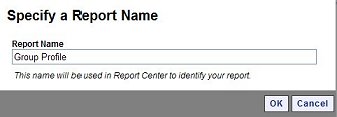Create Gates-MacGinitie Reading Test Reports
|
Field |
Selections |
Description |
|
|
GRADE/LEVEL |
Relevant selections = level 1 or 2 |
Word decoding typically corresponds to grades 1 and 2 but may be tested off-level (as K, level 1, for example, or 3, level 2). |
|
|
Students Coded in Office Use |
● Included ● Excluded |
Refers to the "Office Use Only" section of a student answer document. Identifies students whose test scores should be included or excluded from group averages. |
|
|
REGION/SYSTEM/DISTRICT/ BUILDING/CLASS |
● All (default) ● Specific location |
Determines the population scope of your report. The field name depends on your setup and permissions (for example, BUILDING if you are a Building or School Administrator). If you select a specific location, a new sublevel field opens below. This continues for all available locations (down to the level of CLASS). |
|
|
POPULATION FILTERS |
|
Narrows results by gender, ethnicity, or program (such as IEP or Gifted) |
|
Data Package: Online Testing or DataPlus
Role: Account Holder, Super Admin, Administrator, Teacher, or Digital Resource & Reporting Access
You can specify criteria and run reports on the Create a Report page.
Report options and availability vary according to the following:
● Your role and location. You can create and view reports only for your own location level and those below you.
● The tests that have been administered to students, entered in the database, and marked as completed.
● The options you select as you move down the list of criteria. As you select options, subsequent fields with dependencies on those options may change. (Common fields that produce these changes include REPORT TYPE, LEVEL OF ANALYSIS, and DISPLAY OPTIONS.) When this happens, the page reloads to display new or adjusted fields.
Note: If you are transitioning from Interactive Results Manager (IRM) to DataManager (DM), some menu labels and report names have changed.
![]() See the changes.
See the changes.
|
Menu Selection |
Report Header |
Notes |
||
|---|---|---|---|---|
|
Interactive Results Manager |
DataManager |
Interactive Results Manager |
DataManager |
|
|
ROSTER DISPLAY |
Student Roster |
Roster Display |
Student Roster |
Removed the term "display"; added "student." |
|
STUDENT DISPLAY |
Student Profile |
Display [for Student First Name + Last Name] |
Student Profile [for Student First Name + Last Name] |
Removed the term "display"; added "profile." |
|
STUDENT LABEL DISPLAY |
Student Label |
Student Label Display |
Student Label Display |
Added this report to DataManager. Removed the term "display" from the menu item, not the report header. |
|
STUDENT LONGITUDINAL DISPLAY |
Student Profile |
Longitudinal Display [for Student First Name + Last Name] |
Student Profile [for Student First Name + Last Name] |
This report exists in DataManager's Student Profile report. Select “Longitudinal Line Graph” for the “Display Option” of the Student Profile report. |
|
GROUP ROSTER DISPLAY |
Group Roster |
Group Roster Display |
Group Roster |
Removed the term "display." |
|
GROUP DISPLAY |
Group Profile |
Group Display |
Group Profile [for Group Name] |
Replaced "display" with "profile." |
|
GROUP POPULATION DISPLAY |
Subgroup Roster |
Group Population Display |
Subgroup Roster |
"Group Population Display" changed to DataManager standard "Subgroup Roster" report. |
|
GROUP LONGITUDINAL DISPLAY |
Group Profile |
Group Longitudinal Display |
Group Profile |
This report exists in DataManager's Group Profile report. Select “Longitudinal Line Graph” for the “Display Option” of the Group Profile report. |
|
WORD DECODING SKILLS ROSTER DISPLAY |
Word Decoding Skills Roster |
Word Decoding Skills Roster Display |
Word Decoding Skills Roster Display |
Added this report to DataManager. Removed the term "display" from the menu item, not the report header. |
|
CLASS WORD DECODING SKILLS DISPLAY |
Class Word Decoding Skills |
Class Word Decoding Skills Display |
Class Word Decoding Skills Display |
Added this report to DataManager. Removed the term "display" from the menu item, not the report header. |
|
STUDENT WORD DECODING SKILLS DISPLAY |
Student Word Decoding Skills |
Word Decoding Skills Display [for Student First Name + Last Name] |
Word Decoding Skills Display [for Student First Name + Last Name] |
Added this report to DataManager. Removed the term "display" from the menu item, not the report header. |
To create a Gates-MacGinitie Reading Test report:
1. Open the Create a Report tab in the Reports Center by doing one of the following:
– If you are a Teacher, Administrator, or above, click the Reports menu at the top of the page at any point after signing in. Select Classic if provided a drop-down option.
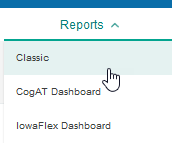
Note: If your institution has purchased CogAT you will also see the option to select the CogAT Dashboard. For instructions on these options, see the related dashboard overview sections.
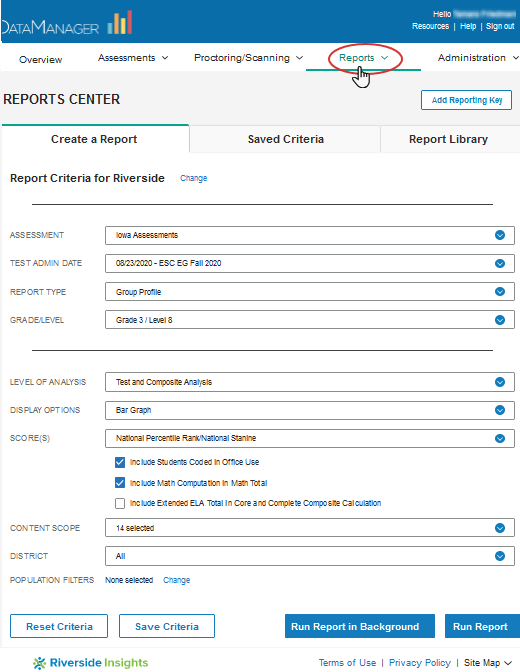
- For individuals with Teacher roles and above, you can also open the Create a Report tab from the Test Events Overview page by clicking See reports in the
 Complete Tasks box.
Complete Tasks box.
Test Events Overview: Admin View
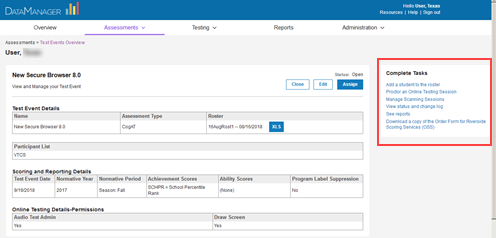
Test Events Overview: Teacher View
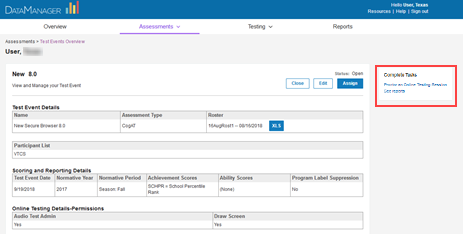
- For reports-only access users with a web Reporting Key, create your account or sign in to your existing account and enter the Reporting Key provided by your school or district administrator.
Note: If you have access to multiple locations, enter each new Reporting Key once. Subsequently, you can select the location from a Select Report Criteria for drop-down list at the top of the Create a Report tab.
2. In the ASSESSMENT list, select the test your students took. If there is more than one option, select the one for which you want to run a report.
3. From the TEST ADMIN DATE list, select your test event if different from the default. Test events are indicated by their date and name. They are sorted by date, most recent first.
4. In the REPORT TYPE list, select the report you want to produce. Short descriptions for each report are provided below, along with links (More...) to fuller descriptions with samples. Click the Instructions link (on the line below More...) to view field-level descriptions and instructions for entering selections in the remaining fields of each report.
Note: Reports and fields are listed here in the same order as they appear on your DataManager platform.
Student Roster – provides scores by test and composite or skill domain for each student in the selected group.
Multimeasure Student Roster – allows you to create up to ten columns across multiple test administrations, test types, grades, and levels for each student in a selected group. This report also provides a PERFORMANCE BANDS option, which allows you to specify performance indicator labels and values that color code the test results for each student.
Student Profile – provides one of several types of data output for each student's scores in a selected group.
Student Label- provides printable student labels containing student and test information, including scores based on vocabulary and comprehension tests.
Creates labels for printing and attaching to student files. The header information includes the student's name and ID, age, class, test level and date, and normative year. The body of the label includes the test results that you select when you run the report.
The report output can be printed on Avery labels (available at most online and brick-and-mortar office supply stores).
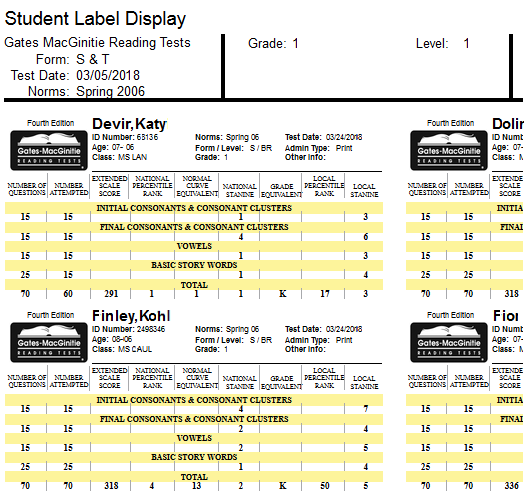
Note: Data in this sample are for illustrative purposes only.
Instructions: Click to open a table with definitions for the remaining fields. When you have entered your report parameters, continue with the next step.
|
Field |
Selections |
Description |
|
|
GRADE/LEVEL |
Grades K - 12, PHS (post high school), and corresponding levels |
Any listed combination of grade and test level. Note the following abbreviations: ● PR = pre-reading ● BR = beginning reading ● AR = adult reading (PHS) Only those grades and levels that were tested are available for selection. |
|
|
SCORES |
1 - all
of the following: |
For more information on scores, see GMRT Score Descriptions See the description of Score Filters below for instructions on how to restrict results to students who scored at or within range of a certain number or percentile.
|
|
|
CONTENT SCOPE |
1 - all of the available: ● Initial Consonants & Consonant Clusters ● Final Consonants & Consonant Clusters ● Vowels ● Basic Story Words ● Literacy Concepts ● Oral Language Concepts ● Letters & Letter/Sound Correspondences ● Listening (Story) Comprehension ● Word Decoding ● Word Knowledge ● Vocabulary ● Comprehension ● Total |
Content Scope options vary by grade and level. All grades and levels include a Total option. |
|
|
REGION/SYSTEM/DISTRICT/ BUILDING/CLASS |
● All (default) ● Specific location |
Determines the location/scope of your report. The field name depends on your setup and permissions (for example, BUILDING if you are a Building or School Administrator). If you select a specific location, a new sublevel field opens below. This continues for all available locations down to the level of CLASS. |
|
|
GROUP POPULATION |
Select 1-2 hierarchy levels |
Compares the group performance on each test item to the performance of 1-2 larger groups (in addition to national performance, which appears by default for every report). Selections are equal to or greater than the report grouping.
|
|
|
POPULATION FILTERS |
categories, 1 selection allowed for each
|
Narrows results by gender, ethnicity, and/or program (such as IEP or Gifted). |
|
Group Roster – provides test and composite scores or skill domain scores for each selected group—class, building, district, system, region, or state.
Subgroup Roster – provides test or composite scores for all subgroups or a selected subgroup—gender, federal race/ethnicity, programs, and/or administrator codes.
Group Profile – provides the average score for a selected group by test, skill domain, content, cognitive level (Cognitive levels provide a hierarchy of critical thinking skills; the three included in the report are Essential Competencies, Conceptual Understanding, and Extended Reasoning.) proficiency level, and/or any population parameters you specify, with some reports offering the option to view longitudinal information where relevant data exists.
Word Decoding Skills Roster – applies to Levels 1 and 2 of the GMRT Word Decoding subtest (grades 1 - 2). Shows the number and category of errors made by class on the Word Decoding subtest of GMRT Level 1 (Form S) and Level 2 (Form S and Form T).
The Word Decoding Skills Roster report shows the number and category of errors made by class on the Word Decoding subtest of GMRT Level 1 (form S) and Level 2 (form S and form T). The alphabetical list of students allows for various sorting and filtering options such as sorting by number of errors (from high to low or low to high) and filtering for the number of errors above, below, or between a specified number. For information on applying filters to this report, see the instructions for running the report (in the list of reports, step 4 of Create Gates-MacGinitie Reading Test Reports).
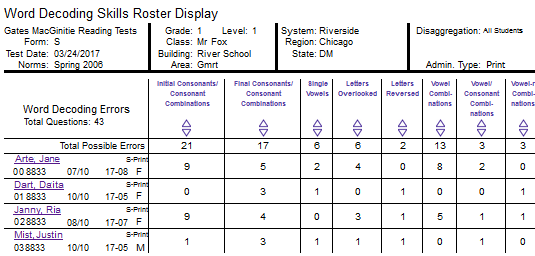
Note: Data in this sample are for illustrative purposes only.
|
Field |
Selections |
Description |
|
|
GRADE/LEVEL |
Relevant selections = level 1 or 2 |
Word decoding typically corresponds to grades 1 and 2 but may be tested off-level (as K, level 1, for example, or at grade 3, level 2). |
|
|
CONTENT SCOPE |
1 or more targeted skills
|
Appears for word decoding levels only (levels 1 and 2). Select one or more to view targeted skills on the report. |
|
|
REGION/SYSTEM/DISTRICT/ BUILDING/CLASS |
● All (default) ● Specific location |
Determines the population scope of your report. The field name depends on your setup and permissions (for example, BUILDING if you are a Building or School Administrator). If you select a specific location, a new sublevel field opens below. This continues for all available locations (down to the level of CLASS). |
|
|
POPULATION FILTERS |
3 categories, 1 selection allowed for each.
|
Narrows results by gender, ethnicity, or program (such as IEP or Gifted) |
|
Class Word Decoding Skills – provides the overall number of errors made by a class on each of the skills in GMRT Level 1 (Form S) or Level 2 (Form S and Form T).
The Class Word Decoding Skills report provides the overall number of errors made by a class on each of the Skills in GMRT Level 1 (form S) and Level 2 (form S and form T).
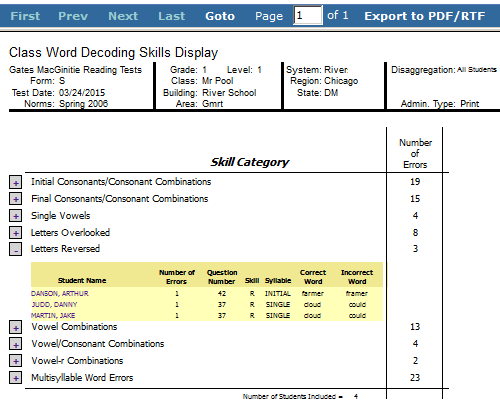
Note: Data in this sample are for illustrative purposes only.
|
Field |
Selections |
Description |
|
|
GRADE/LEVEL |
Relevant selections = level 1 or 2 |
Word decoding typically corresponds to grades 1 and 2 but may be tested off-level (as K, level 1, for example, or 3, level 2). |
|
|
Students Coded in Office Use |
● Included ● Excluded |
Refers to the "Office Use Only" section of a student answer document. Identifies students whose test scores should be included or excluded from group averages. Included: Overrides exclusions; those test scores marked for exclusion will be used in computing group averages. Excluded: Test scores marked for exclusion will not be used in computing group averages; those test scores will be reported on individual student score reports. |
|
|
REGION/SYSTEM/DISTRICT/ BUILDING/CLASS |
● All (default) ● Specific location |
Determines the population scope of your report. The field name depends on your setup and permissions (for example, BUILDING if you are a Building or School Administrator). If you select a specific location, a new sublevel field opens below. This continues for all available locations (down to the level of CLASS). |
|
|
POPULATION FILTERS |
3 categories, 1 selection allowed for each.
|
Narrows results by gender, ethnicity, or program (such as IEP or Gifted) |
|
Student Word Decoding Skills – shows the skill category and number of errors made by each student in a class on the Word Decoding subtest of GMRT Level 1 (Form S) and Level 2 (Form S and Form T). Skill Categories can be expanded to see the exact errors students made on the subtest.
The Student Word Decoding Skills report shows a student's errors, per skill category, on the Word Decoding subtest of GMRT Level 1 (form S) and Level 2 (form S and form T). When setting report parameters, you can select a single student or an entire class with a page for each student, as indicated in the blue navigation menu below (Page 1 of 14).
Skill Categories can be expanded to see the exact errors students made on the subtest, as in the Vowel Combinations expanded in the image below.
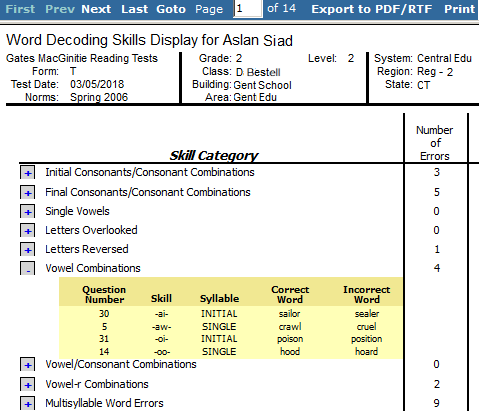
Note: Data in this sample are for illustrative purposes only.
|
Field |
Selections |
Description |
|
|
GRADE/LEVEL |
Relevant selections = level 1 or 2 |
Word decoding typically corresponds to grades 1 and 2 but may be tested off-level (as K, level 1, for example, or at grade 3, level 2). |
|
|
Students Coded in Office Use |
● Included ● Excluded |
Refers to the "Office Use Only" section of a student answer document. Identifies students whose test scores should be included or excluded from group averages. Included: Overrides exclusions; those test scores marked for exclusion will be used in computing group averages. Excluded: Test scores marked for exclusion will not be used in computing group averages; those test scores will be reported on individual student score reports. |
|
|
REGION/SYSTEM/DISTRICT/ BUILDING/CLASS |
● All (default) ● Specific location |
Determines the population scope of your report. The field name depends on your setup and permissions (for example, BUILDING if you are a Building or School Administrator). If you select a specific location, a new sublevel field opens below. This continues for all available locations (down to the level of CLASS). |
|
|
STUDENT |
1 name from the list or All |
All available students from the location (see field above) appear in a drop-down menu. Select one name to view an individual report or select All to return a page/report per student for the entire location. |
|
5. (Optional) Save the current selection criteria for future use.
a. Click the Save Criteria button in the lower left corner of the page . A Save Criteria box opens. The report name defaults to the Report Type you selected.
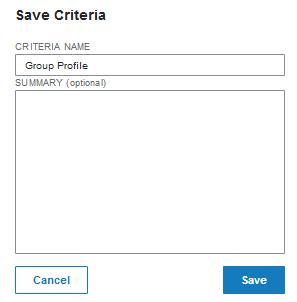
b. Type in the CRITERIA NAME box to change or add to the name of the saved criteria. To add a description, use the SUMMARY box
Note: The CRITERIA NAME can be a maximum of 80 characters. The SUMMARY can be a maximum of 255 characters.
c. Click Save.
○ If the report name does not already exist, a confirmation message appears at the top of the page. Continue to step d.
○ If the report name does already exist, a Report Name Exists box appears.
Do one of the following:
○ To change the selection criteria that were saved under this report name with the updated selected criteria, click Yes. A confirmation dialog box appears. Continue to step d.
○ To retain the selection criteria that were saved under this report name and save the updated selection criteria under a new report name, click No. A Save Report Criteria dialog box opens with an empty Report Name box. Return to step b.
d. Click OK. The saved selection criteria is available on the Load/Manage Criteria page. For more information, see Loading and Managing Saved Criteria .
6. Run the report using one of the following options.
|
To do the following... |
Follow these instructions... |
|
Run the report immediately as you wait. |
a. Click Run Report. A progress bar appears. When the report has finished running, it appears on a report page. b. See View Reports for information about the report page.
|
|
Submit the report to run in the background. |
a. Click Run in Background. A Specify a Report Name dialog box opens. The report name defaults to the Report Type.
b. (Optional) Change or add to the Report Name.
c. Click OK. A confirmation box informs you that the job has been submitted successfully. d. Click OK. The report is submitted. When it is finished running, you can open it in the Report Cente . e. See Using the Report Center for information about retrieving reports.
|
See Also:

